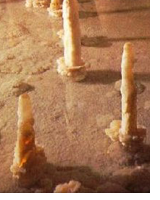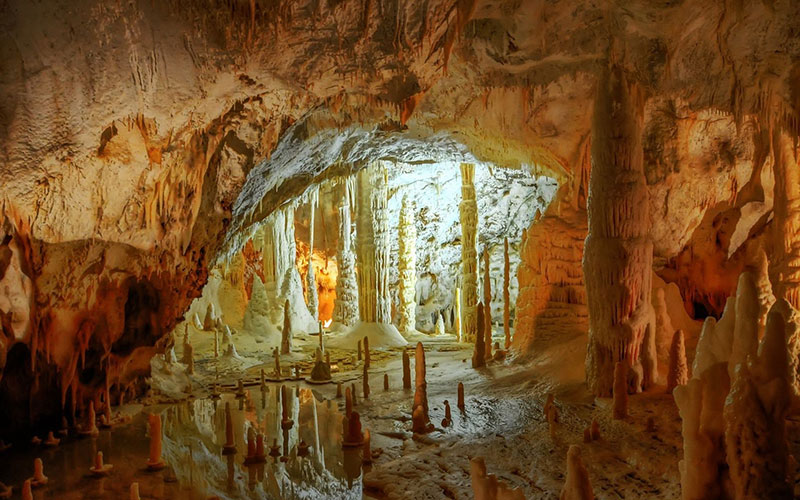History
We can state with certainty that a systematic search for speleologists and geologists in the Frasassi area began in 1948, thanks to the activity of the Marche Speleological Group of Ancona. It must be remembered, however, that even in the period between the two wars there were some explorations and research by prehistoric and natural science scholars, but they were sporadic episodes. Precisely in 1948, and precisely on 28 June, Mario Marchetti, Paolo Beer and Carlo Pegorari of the aforementioned Speleological Group discovered the entrance to the River Cave.
Numerous other explorations and discoveries will be made in the area, thanks to the Cave Groups of the Italian Alpine Club (C.A.I.) of Jesi and Fabriano. In 1966, a member of the Fabriano Speleological Group, Maurizio Borioni, found a further branch inside the River Cave, over a kilometer long. From this moment the explorations and research became more assiduous and enthusiastic.
Five years later, in July 1971, a new discovery. This time some young people from Jesi find themselves faced with a narrow opening from which a notable current of air comes out. They are Armando Antonucci, Mauro Brecciaroli, Mauro Coltorti, Mario Cotichelli, Massimo Mancinelli, Giampiero Rocchetti and Roberto Toccaceli. They worked for about a month to widen the narrow passage, and on the following first August they passed what would be called the “Woodworm Narrows”. Approximately five kilometers of new cavities will thus be opened up to the wonder of young people, with a set of tunnels, wells and imposing tunnels, within which they will find animal traces preserved over the millennia. The discoveries of this lucky year do not end here.
 The first trace of the most important discovery, that of the Grotta Grande del Vento, occurred on 25 September 1971, when Rolando Silvestri of the Gruppo Speleologico Marchigiano Italian Alpine Club of Ancona, crossing the northern slopes of Mount Vallemontagnana, discovered a small entrance. With the help of some friends he managed to open a passage into a small room.
The first trace of the most important discovery, that of the Grotta Grande del Vento, occurred on 25 September 1971, when Rolando Silvestri of the Gruppo Speleologico Marchigiano Italian Alpine Club of Ancona, crossing the northern slopes of Mount Vallemontagnana, discovered a small entrance. With the help of some friends he managed to open a passage into a small room.
The disappointment at the small discovery was almost immediately accompanied by the hope that something much bigger was in sight. In the small room, in fact, there were numerous openings from which air currents escaped. After a tiring digging job, which will last a few days, they entered a narrow passage and from there slipped towards the edge of a void.
They threw a stone into the void and realized the width and depth of the cave. Their calculation, not far from the truth, was over one hundred meters. An incredible discovery, which created great enthusiasm among the members of the group. The marvelous Grotta Grande del Vento was thus handed over to the admiration of man. The problem then became for them to try to penetrate the cavity and reach the bottom. They quickly equipped themselves with the necessary equipment and, with a new expedition, lowered themselves into the enormous cave below which would be given the name “Ancona Abyss”.
The lights of the Ancona speleologists immediately highlighted the splendor and singular beauty of this new environment. The discovery was spread and made known also through the press. The activities of the Speleological Group of Jesi and the Ancona Group then continued and intensified, the first in the Grotta del Fiume and the second in the Grotta Grande del Vento. Their objective was to find the conjunction, the communication route between the two cavities that they believed must necessarily exist.
Their belief and their tiring research will be realized about two months later, on December 8, but they will be some speleologists from the C.A.J. of Fabriano to follow the traces of the Ancona speleologists in the Grotta Grande del Vento. They also gave a name to that passage: “Conduct of the Fabriano people”. The two enormous caves thus became, from now on, an enormous labyrinth of underground environments that follow one another incessantly for over thirteen kilometers.
Only speleologists, with particular equipment and not without certain difficulties, are able to explore this stupendous underground world in its entirety; the others are left with only the photos, beautiful as they are. At the end of 1972 the “Frasassi Consortium” was established, with the aim of safeguarding and enhancing the Frasassi caves and the municipal territory within which they are located. The Consortium was established between the Municipality of Genga and the Province of Ancona. An artificial tunnel of over 200 meters was built, which led to the entrance to the Grotta Grande del Vento, and then a comfortable path of about 600 meters was traced inside. Cesarini from Senigallia was commissioned to take care of the lighting and he did it masterfully. The minimum conditions were thus achieved to make one of the most beautiful parts of the Grotta Grande del Vento accessible to tourists.
The opening dates back to 1 September 1974; since then numerous tourists continue to visit these enchanting places where they can appreciate the beauty, splendor and majesty of nature.

